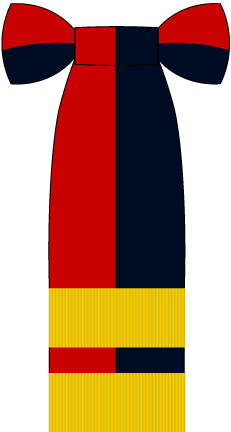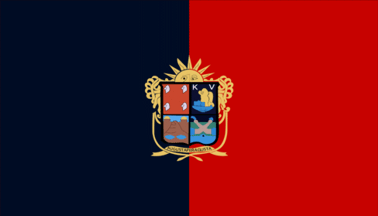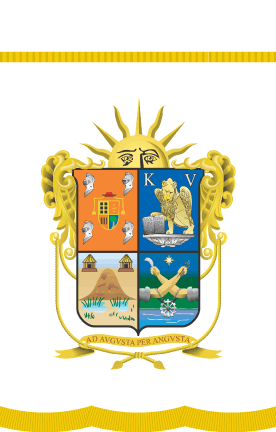

By Daniel Rentería, 24 July 2022
1 | from regeneraciongto.com
*Flag uses a navy blue/red cravat (not adopted officially by any regulation).

Last modified: 2025-07-26 by daniel rentería
Keywords: irapuato | strawberry | fresa | frutilla | guanajuato | bandera municipal y escudo municipal (guanajuato) | escudo del municipio (guanajuato) | bandera del municipio (guanajuato) | héraldica municipal de guan |
Links: FOTW homepage |
search |
disclaimer and copyright |
write us |
mirrors


By Daniel Rentería, 24 July 2022
1 |
from
regeneraciongto.com
*Flag uses a navy blue/red cravat (not adopted officially by any regulation).
See also:
A distinctive flag of Irapuato, Guanajuato, began to be used since late 2015 during the last year of the government headed by Sixto Zetina Soto, who was mayor of Irapuato from 2012 to 2015. The flag was sighted for the first time at the speech for the delivering of the 3rd Government Report on 1 October 2015. The flag remained in use during both consecutive tenures of Ricardo Ortiz Gutierrez (2015 - 2018 and 2018 - 2021). Under Lorena del Carmen Alfaro García, mayor since 2021, the flag has been scarcely used, it has been seen in counted occasions like the international forum "Interconectando Ciudades Inteligentes" (February 2022), the signing of the agreement with the in March 2022 UNESCO, and business meeting with ASEAN countries in May 2022.
Juan Manuel Gabino Villascán, 24 July 2022
The flag of Irapuato has not been adopted by any regulation officially. It is divided into red and navy blue, and the coat of arms of the city is placed in the center taking approximately half of its height. A cravat is also unofficially used using the navy blue and red colors.
Daniel Rentería, 4 June 2025
 by Daniel Rentería, 24 July 2022
by Daniel Rentería, 24 July 2022
flag photo
from Gobierno de Irapuato
The standard is that of the Irapuato council.
Juan Manuel Gabino Villascán, 24 July 2022
.gif)
from Wikimedia Commons
The council informs me that the origin of the coat of arms is in 1946, when preparing for the 400th anniversary of its foundation on 15 February 1947. The "Alborada" magazine organized a contest for the adoption of an Irapuato coat of arms, having six participants; none of the designs convinced the jury, who declared the contest deserted. From that time, the work of creating the symbol was given to the painter José Dolores Aguilera and assessed by local historian Pedro Vargas Covarrubias. The magazine was satisfied by the design, and gave it to the Pro-Irapuato Committee in charge of the festivities. Although being presented on the aforementioned anniversary, it was not until 2 October 1953 that the council approved it as official. It is based on the heraldic coats of arms of Spain.
Above the shield is a sun with a face, signifying clarity, abundance, and wealth, and is inspired by the Hospitalito Temple's facade. Shells on the left and right sides carry a ribbon from the bottom, which reads the motto "AD AVGVSTA PER ANGVSTA" [To the Highest through the Hardest Path; recognizing the hard work of the inhabitants]. The upper-left section depicts four helmets in the corners, representing the four Spanish captains: Esteban Gamiño, Francisco Hernández, Andrés López and Antonio Francisco de Sixtos, the original colonizers of Irapuato. In the center is the coat of arms of the first bishop of Michoacán, Vasco de Quiroga; recognized as the founder of the Hospitalito Temple and the parish: in the upper-left are four cubes, the upper-right has a cross, the lower-left four bars, and the last has a tree, with the decoration of a bishop's coat of arms around it.
The upper-right section depicts a winged lion carrying a book on a pedestal, representing Saint Mark since its founding name was San Marcos de Irapuato; above it, the initials "K V" signify Karolus V or Carlos V, king of Spain who issued the founding decree of Irapuato. The lower-left section refers to the possible etymologies of Irapuato: "place of low houses" (two pre-Hispanic huts above) or "hill that emerges from the plain" (in the center representing the Bernalejo Hill, over swamps found before the Spanish times). The lower-right section depicts two crossed arms: the one to the left carries a caduceus of the god Mercury, symbol of commerce; while the other carries a sickle of agriculture, the primary industries in the 20th century. Both arms are tied together by a cogwheel, symbolizing industry. Above them, a compass rose symbolizes the strategic position of Irapuato.
Daniel Rentería, 4 July 2025
Anything below this line was not added by the editor of this page.